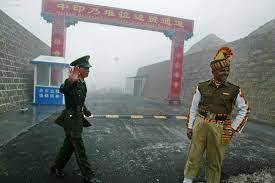
Ayesha Siddiqa: India and China have just pulled back from the Line of Actual Control (LAC) and there seems to be some peace.
Manoj Joshi: In April-May 2020, China blockaded the Indian side in Ladakh and massed troops opposite the LAC in Ladakh. This led to a collapse of the confidence-building measure (CBM) regime that India and China had worked out since the 1990s. The peacekeeping regime prohibited the use of guns. From 1993 to 2020 there had not been a single casualty in the LAC area.
Ayesha Siddiqa: So the nature of the conflict has changed substantially.
Manoj Joshi: In eastern Ladakh mutual trust has come crashing down. India permitted its soldiers to use guns to defend themselves.
Ayesha Siddiqa: Some say it was a provocation from India through infrastructural growth on the border.
Manoj Joshi: India-China border is completely asymmetrical. And India seems to be 25 years behind China in infrastructure in the rough border terrain. China has far superior infrastructure for all their posts.
Ayesha Siddiqa: Now that troops have pulled back, is peace going to happen?
Joshi: Now, each side will pull back now a few kilometers with a No Patrol Zone in between. The second stage of disengagement was to withdraw troops. The second stage has not come - India wants disengagement in all five areas. Both sides have heavy military formations. But neither side has enough military to overwhelm the other, where the other feels a military attack is imminent.
Siddiqa: What about Indian capacity? How far will India take the conflict given the huge dependency on trade with China?
Joshi: After 2020, India has deployed a strike corps on its Chinese border too. There are parts of the border that are 300-400 kilometers from the Indian Heartland like Delhi, whereas for Indians, the Chinese Heartland is at least 3000 kilometers away. India would be at a disadvantage in a long-range conflict.
China still dominates the bilateral trade. Some reports suggest that China is India’s leading trading partner. India, like the rest of the world, does not have many options as China is the world’s leading manufacturing power.
Siddiqa: Normally we think trade solves issues.
Joshi: The US and China are far more deeply entangled in trade and far more antagonistic than India and China. India and China still have major interactions and talks. The logic that trade and mutual interdependence always avoids conflict doesn’t work anymore.
Siddiqa: If there is a US-China war in Taiwan, how will India react?
Joshi: India is facing the PLA one-on-one and PLA is building up in Tibet since 2017. In terms of Taiwan conflict, India would avoid direct involvement in naval conflict. However, because of its location on the Malacca Straits and Nicobar Islands, if there is a US-led blockade of China, India could participate.
Siddiqa: China will consider it a direct confrontation if India participates in such a blockade.
Joshi: India may use harassment techniques to make Chinese trade difficult, for example checking contraband items going to Pakistan.
Siddiqa: Why not talk? At the SCO Summit, PM Modi and Xi Jinping hardly engaged. As India resumes leadership of SCO, where does India stand?
Joshi: Bilateral interactions were fine before 2020. But with the breakdown of trust in April-May 2020, China’s coercive actions changed everything.
India and China do have adequate bilateral contact but Narendra Modi hardly engaged with Xi Jinping at the recent SCO Summit. It seems unlikely that India will use the SCO platform to bring down the temperature.
Siddiqa: India talks about a multipolar world where it can juggle between China, US, Russia. How will it do that without talking? Isn’t this a variant of nonalignment that has not served India?
Joshi: In geopolitics, there is a real world and militaries do their own thing. “Comprehensive National Power” measurement by China shows that China is becoming stronger and India is stagnant. India wants to use its relationship with the West to balance China. Multipolarity will be considered for trade and climate change but when it comes to raw power and geopolitics the Indian course is dictated by its own weakness.
Siddiqa: How will India match up to China? How will it become confident enough for a two-front war?
Joshi: It would take a decade or two of high economic growth. Indian growth has stalled after PM Manmohan Singh’s time.
Siddiqa (conclusion): The linkage between economic growth and military growth: the two are dependent. We think that a strong military is the recipe for a strong economy. Here is the case for a strong economy making up for what India lacks at the moment vis-a-vis China.
https://www.youtube.com/watch?v=4h--Gv5tKmM

